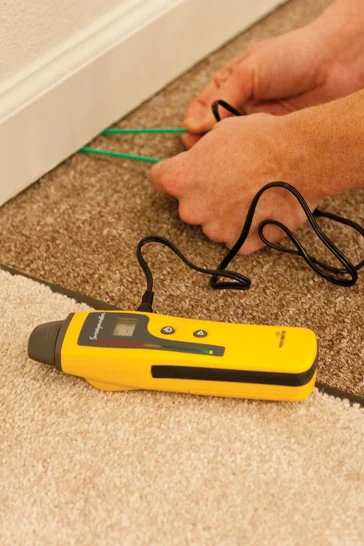Your Professional Moisture Meter’s Not Working -- Why?
Chris Ranwell
Dec 7, 2021 8:00:00 AM

It’s the last thing a home inspector wants to deal with when conducting a moisture survey. Just as you’re in the throes of an inspection, your moisture meter suddenly stops working as it should.
Does that mean your inspection is over until you get a new meter if you don’t already have one on hand?
Not necessarily.
Even with the most meticulous care, sometimes issues come up that make it seem like your professional moisture meter is starting to go on the fritz.
To be sure, like any of your other favorite tools, issues sometimes come up that affect your meter’s functionality.
Not to worry -- in most cases the reason your moisture meter’s not working is simple and easy to address.
5 Simple Reasons Your Professional Moisture Meter Might Not Be Working
Your professional moisture meter … acting up … in the middle of a job might leave you wondering if you missed the part about how does a moisture meter work. Your immediate reaction that there must be something incredibly wrong with your meter isn’t uncommon. However, it’s important to keep perspective -- if you’ve invested in a professional grade meter and taken good care of it, chances are the issue stopping it from working correctly is nothing you can’t diagnose and fix.
The most common reasons a moisture meter stops working are:
- No power
- External damage
- Internal damage
- Out-of-date firmware
- Calibration is off
1. No Power
One of the most common reasons a professional moisture meter appears not to be in working order is because it suddenly turns off or doesn’t turn on to begin with.
In the middle of a job, having a moisture meter turn off but not on again is about as frustrating as having your mobile phone die when there’s not a charger around.
Alarming as this may seem, this is one of the easiest problems to diagnose and fix: recharge or replace the device’s batteries.
To avoid this issue in the field, we recommend these basic best practices:
- Double-check your meter’s power before leaving for a job.
- Always carry a spare battery or two.
- Check the battery contact in case a leaking battery has caused corrosion
2. External Damage
While professional moisture meters are durable and can last for decades with the right care, they’re not indestructible. An accidental drop off of a high ladder onto a concrete floor might not be a non-event for the device.
External damage to your meter comes in many forms. When inspecting for obvious irregularities to your meter’s appearance, check for:
- Bent pins (for pin-type moisture meters)
- Cracked casing
- Deep scratches/gouges
- Worn-out contact plate (for pinless moisture meters)
- Broken digital display
3. Internal Damage
Sometimes it’s the damage you can’t see that makes your moisture meter seem like its next trip is to the dump.
Many of the same causes for external damage to your meter may be the culprit for damage to its internal components.
The best way to check for internal damage is to gently shake your meter. If you hear a rattling noise or feel residual movement, there are likely broken internal components, such as a circuit board or detached wire.
Your best bet is to call the manufacturer and discuss repair options.
4. Out-of-Date Firmware
Some newer moisture meters have the ability to update the internal firmware. The lowest level of software, firmware essentially tells your device how to work. Every so often your moisture meter’s manufacturer may update your meter’s firmware to fix software bugs or enhance functionality. It’s no different than your smartphone’s manufacturer requiring you to install the latest operating system or security update.
It’s a good idea to periodically check your manufacturer’s website for new firmware releases to ensure your meter is working as they intend.
Resource: Updating firmware on Protimeter moisture meter, such as the Hygromaster 2 or MMS2, is a simple process. See for yourself:
5. Calibration is Off
After many uses, occasionally a moisture meter doesn’t take as accurate measurements as it’s supposed to.
That’s where checking the calibration is invaluable.
A process that generally takes no longer than a minute to complete, checking the calibration of your meter before use ensures its readings are correct and the device is functioning properly. Whether you’re using a pinless or a pin-type meter, your manufacturer usually provides the accouterments to calibrate your meter.
Verifying that your meter is calibrated is easy. For pin-type meter measurement, use the check device that comes with your meter. Some meters have an internal check feature. With non-invasive meters, compare reading with another meter. Some newer pinless meters, such as the Protimeter Reachmaster Pro and MMS3, have the ability to re-calibrate this function by the user in the field. For hygrometers keep a spare replaceable probe as you reference and check your field probe against it regularly.
Avoiding Your Moisture Meter Not Working in the First Place
No one wants to have a toolbox full of tools they’re not sure will stand up to normal demand or last long. Purchasing sub-par equipment is essentially throwing money away, as it’s bound to fail at some point (usually when you need it the most).
The best way to ensure you’re always completing a job with a moisture meter you can count on is to invest in a high-quality, professional-grade moisture meter to begin with (not the $50 or less meters at your favorite big-box retailer).
Professional moisture meters by a reputable manufacturer are made to last and designed for durability.
It’s also a good idea to keep your meter protected when you’re not using it. Storing your meter in its supplied case prevents accidental damage.
Find the Last Moisture Meter You’ll Ever Need to Buy
Browse our catalog of professional moisture meters made to stand up to all the demands of a home inspection:
